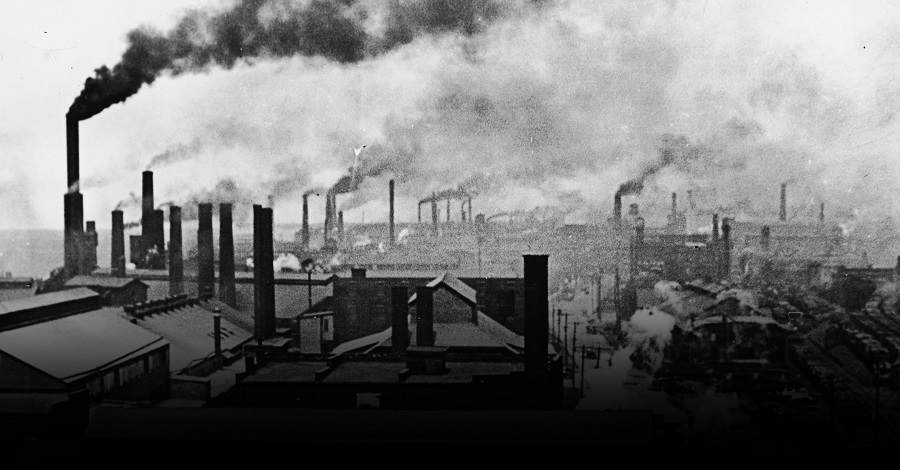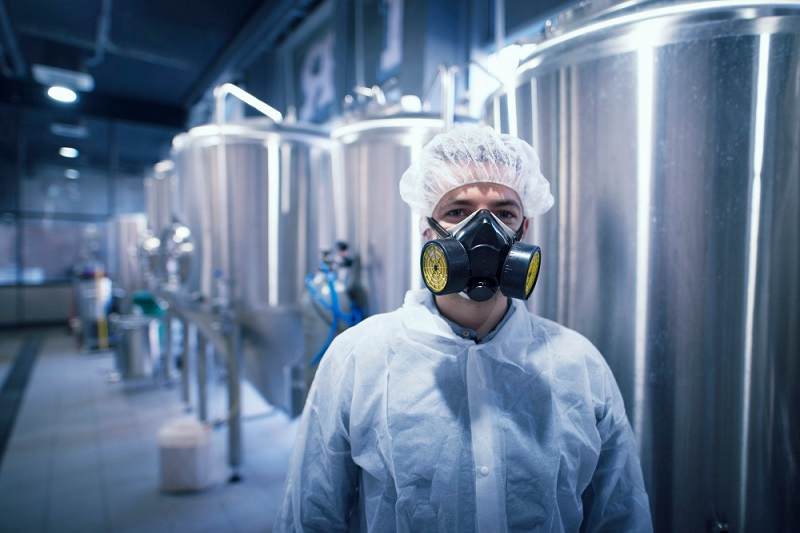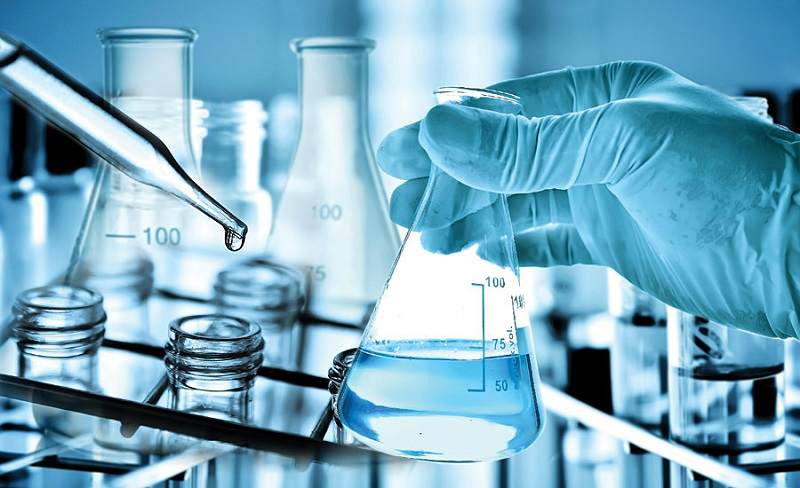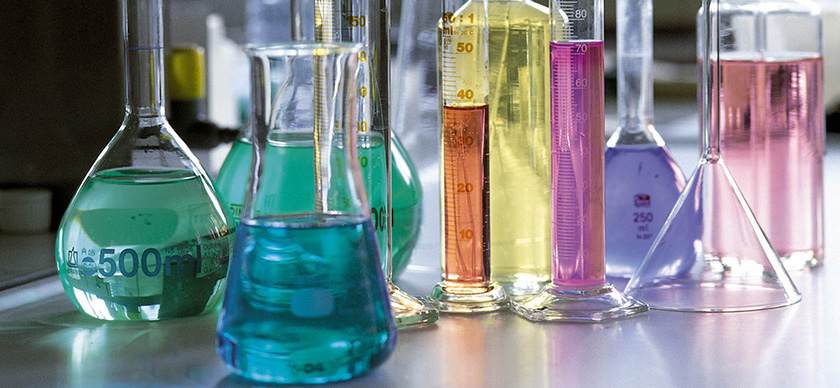Chemical industries are industries that use chemical compounds to produce products. These industries include the production of primary chemicals, polymers, paints, rubber, pharmaceutical industries, fertilizers, detergents and sanitary materials, oil and gas, etc.
Also, chemical industries include companies that develop and produce industrial chemicals, specialized and other chemicals. At the center of the modern global economy, the chemical industry transforms raw materials (oil, natural gas, air, water, metals and minerals) into industrial and consumer products. Various professionals, including chemical engineers, chemists, and laboratory technicians, work in the chemical industry. Although chemicals have been manufactured and used throughout history, the birth of the heavy chemical industry (production of chemicals in large quantities for various uses) ) coincided with the beginning of the industrial revolution.
industrial revolution
One of the first chemicals to be produced in large quantities through industrial processes was sulfuric acid. In 1736, apothecary Joshua Ward developed a process for its manufacture that involved heating sulfur with salt, allowing the sulfur to oxidize and combine with water. This was the first practical production of sulfuric acid on a large scale. John Roebuck and Samuel Garbett were the first to establish a large-scale factory in Prestonpans, Scotland in 1749 that used lead-condensed chambers to produce sulfuric acid.
Sulfuric acid was used as a more efficient agent as well as lime in the mid-18th century, but it was the discovery of bleaching powder by Charles Tennant that gave rise to the first major chemical industry. His powder was made by reacting chlorine with slaked lime and proved to be a cheap and successful product. He opened a factory in St. Rolex, north of Glasgow, and production rose from 52 tons in 1799 to almost 10,000 tons just five years later.
Sodium carbonate or soda ash has been used since ancient times in the production of glass, cloth, soap and paper, and the source of potash was traditionally wood ash in Western Europe. In the 18th century, this resource became uneconomic due to deforestation, and the French Academy of Sciences offered a prize of 2,400 livres for a method of producing alkali from sea salt (sodium chloride). Leblanc process in 1791 by Nicolas Leblanc who then built a Leblanc factory in St. Denis.
In Britain, the Leblanc process became popular. William Lush built the first soda works in Britain on the River Tyne in 1816, but due to high tariffs salt production remained on a small scale until 1824. When these tariffs were abolished, the British soda industry was able to expand rapidly. As the industrial revolution matured, these huge factories began to produce a greater variety of chemicals. Originally, large amounts of alkaline waste from soda production were discharged into the environment, prompting one of the first environmental laws to be passed in 1863.

The Solvay process was developed by Belgian industrial chemist Ernest Solvay in 1861. In 1864, Solvay and his brother Alfred built a factory in Charlevoix, Belgium. In 1874, they expanded to a larger factory in Nancy, France. The new process was more economical and less polluting than the Leblanc method, and its use spread.
Production of chemical products from fossil fuels began on a large scale in the early 19th century. Coal tar and ammonia residues from coal gasification for gas lighting were processed in 1822 at Bonnington Chemical Works in Edinburgh to make naphtha, carbon black and ammonia. Ammonium sulfate fertilizer, road asphalt, coke oil and coke were later added to the product line.
Expansion of the chemical industry
At the end of the 19th century, we saw an explosion in both the amount of production and the types of chemicals produced. Large chemical industries arose in Germany and later in the United States.
The production of synthetic fertilizers for agriculture was pioneered by Sir John Laws at the purpose-built Rothamsted Research Centre. In the 1840s he established large works near London for the production of superphosphate of lime. Rubber vulcanization processes were patented by Charles Goodyear in the United States and Thomas Hancock in England in the 1840s. The first synthetic dye was discovered by William Henry Perkin in London. He partially converted aniline into a crude mixture which, when extracted with alcohol, produced a violet-colored substance. He also produced the first synthetic perfumes. German industry quickly dominated the field of synthetic dyes. The big three companies BASF, Bayer and Hoechst produced hundreds of different colors. By 1913, German industries produced approximately 90% of the world’s dyestuffs and sold approximately 80% of their production abroad. In the United States, Herbert Henry Dow’s use of electrochemistry to produce chemicals from salt water was a commercial success that helped boost the country’s chemical industry.

The petrochemical industry can be traced back to the petroleum work of Scottish chemist James Young and Canadian Abraham Pineau Gessner. The first plastic was invented by Alexander Parkes, an English metallurgist. In 1856, he patented parkzine, a nitrocellulose-based celluloid treated with a variety of solvents. Exhibited at the 1862 London International Exhibition, this material foreshadowed many of the modern aesthetic and functional uses of plastic. The industrial production of soap from vegetable oils was started by William Lorre and his brother James in 1885 in Lancashire based on a modern chemical process invented by William Hough Watson that used glycerine and vegetable oils.
In the 1920s, chemical companies merged into large conglomerates such as IG Farben in Germany, Rhône-Poulenc in France, and Imperial Chemical Industries in Britain.
Polymers and plastics such as polyethylene, polypropylene, polyvinyl chloride, polyethylene terephthalate, polystyrene and polycarbonate make up about 80% of the industry’s production worldwide. These materials are often made into fluoropolymer pipe products and are used by industry to transport highly corrosive materials. Chemicals are used in many different consumer goods. These uses include: agricultural production, construction, and service industries. Major industrial customers include rubber and plastic products, textiles, clothing, oil refining, pulp and paper, and primary metals. Chemicals are an approximately $5 trillion global industry, with the European Union and US chemical companies being the world’s largest producers.
Chemical business sales can be divided into several broad categories, including basic chemicals (about 35% – 37% of production dollars), life sciences (30%), specialty chemicals (20% – 25%) and consumer products. (about 35%) 10 percent.
Basic chemicals or “commodity chemicals” are a broad chemical category including polymers, bulk petrochemicals and intermediates, other derivatives and base industries, inorganic chemicals, and fertilizers. Polymers are the largest revenue segment and include all plastics and fiber categories. Major markets for plastics include packaging followed by home construction, containers, home appliances, pipes, transportation, toys and games.
The largest volume polymer product, polyethylene (PE), is mainly used in packaging films and other markets such as milk bottles, containers and pipes.
Polyvinyl chloride (PVC), another high-volume product, is primarily used to make piping for the construction markets as well as siding, and to a lesser extent for shipping and packaging materials.
Polypropylene (PP), similar in volume to PVC, is used in a variety of markets, from packaging, home appliances and containers to clothing and carpets.
Polystyrene (PS), another high-volume plastic, is used primarily for home appliances and packaging, as well as toys and entertainment. Leading man-made fibers include polyester, nylon, polypropylene, and acrylic, with Applications include clothing, home furniture and other industrial and consumer uses. The main raw materials of polymers are bulky petrochemicals such as ethylene, propylene and benzene.
Petrochemicals and chemical intermediates are mainly made from liquefied petroleum gas (LPG), natural gas, and crude oil fractions. High volume products include ethylene, propylene, benzene, toluene, xylene, methanol, vinyl chloride monomer (VCM), styrene, butadiene and ethylene oxide. These primary or commodity chemicals are the raw materials used to produce many polymers and other more complex organic chemicals, especially those made for use in specialty chemicals. Other derivatives and base industries include Synthetic rubber, surfactants, dyes and pigments, turpentine, resins, carbon black, explosives and rubber products, and about 20% of foreign sales of basic chemicals.
Mineral chemicals (about 12% of output) are the oldest chemical categories. Products include salt, chlorine, caustic soda, soda ash, acids (such as nitric acid, phosphoric acid, and sulfuric acid), titanium dioxide, and hydrogen peroxide. Fertilizers are the smallest category (about 6 percent) and include phosphates, ammonia, and They are chemically potassium.

Life sciences
Life sciences (about 30 percent of chemical business dollar production) include specialty chemicals and biologicals, pharmaceuticals, diagnostics, animal health products, vitamins, and pesticides. While their volumes are much smaller than other chemical sectors, their products tend to command high prices—more than ten dollars per pound—growth rates of 1.5 to 6 times GDP, and R&D spending at 15 They include 25% of sales. Life sciences products are usually manufactured to high specifications and are carefully scrutinized by government agencies such as the Food and Drug Administration. Pesticides, also called “crop protection chemicals,” make up about 10 percent of this category and include herbicides, insecticides, and fungicides.
Specialty chemicals
Specialty chemicals are a relatively valuable and fast-growing class of chemicals with diverse end-product markets. Typical growth rates are one to three times GDP at prices above one dollar per pound. They are generally characterized by their innovative aspects. Products are sold for what they can do rather than what chemicals they contain. The products include electronic chemicals, industrial gases, adhesives and sealants as well as coatings, industrial and institutional cleaning chemicals and catalysts. In 2012, excluding fine chemicals, the $546 billion global specialty chemicals market comprised 33% paints, coatings and surface treatments, 27% advanced polymers, 14% adhesives and sealants, 13% additives, and 13% pigments and inks.
Large chemical industry companies
The largest chemical manufacturers today are global companies with international operations and factories in multiple countries. Below is a list of the top 10 chemical companies by chemical sales in 2015.
Top chemical companies by chemical sales in 2015
| rank | Company Name | Sales of chemicals 2015 (in billions of dollars) | country name |
| 1 | BASF | $63.7 | Ludwigshafen, Germany |
| 2 | Dow Chemical Company | $48.8 | Michigan, United States |
| 3 | Sinopec | $43.8 | Beijing, China |
| 4 | SABIC | $34.3 | Riyadh, Saudi Arabi |
| 5 | Formosa Plastics Corporation | $29.2 | Kaohsiung City, Taiwan |
| 6 | INEOS | $28.5 | London, United Kingdom |
| 7 | ExxonMobil Corp. | $28.1 | Texas, United States |
| 8 | LyondellBasell | $26.7 | Texas, United States, and London, United Kingdom |
| 9 | Mitsubishi Chemical | $24.3 | Tokyo, Japan |
| 10 | DuPont | $20.7 | Wilmington, Delaware, United States |
Consumer products
Consumer products include direct sales of chemical products such as soap, detergents and cosmetics. A typical growth rate is 0.8 to 1.0 times GDP.
Consumers rarely come into contact with primary chemicals. Polymers and specialty chemicals are materials that are encountered everywhere on a daily basis. For example, we can mention plastics, cleaning materials, cosmetics, paint and coating, electronic equipment, cars and materials used in house construction. These specialized products are used by chemical companies in manufacturing industries as pesticides. , specialized polymers, electronic chemicals, surfactants, construction chemicals, industrial cleaners, flavors and fragrances, specialized coatings, printing inks, water-soluble polymers, food additives, paper chemicals are marketed. Chemical companies rarely sell these products directly to the consumer.
The American Chemistry Council annually tabulates the production volume of the top 100 chemicals in the United States. In 2000, the total production volume of the top 100 chemicals totaled 502 million tons, up from 397 million tons in 1990. The top 11 chemicals out of 100 chemicals in 2000 were sulfuric acid (44 million tons), nitrogen (34 million tons), ethylene (28 million tons), oxygen (27 million tons), lime (22 million tons), Ammonia (17 million tons), propylene (16 million tons), polyethylene (15 million tons), chlorine (13 million tons), phosphoric acid (13 million tons) and diammonium phosphate (12 million tons).

From the point of view of chemical engineers, the chemical industry involves the use of chemical processes such as chemical reactions and refining methods to produce a wide variety of solid, liquid and gaseous substances. Most of these products are used to make other items, although a smaller number go directly to consumers. Solvents, pesticides, detergents, and Portland cement provide a few examples of products used by consumers.
This industry includes producers of inorganic and organic-industrial chemicals, ceramic products, petrochemicals, agricultural chemicals, polymers and rubber (elastomers), oleochemicals (oils, fats and waxes), explosives, perfumes and flavorings. Related industries include petroleum, glass, paints, inks, sealants, adhesives, pharmaceuticals, and food processing.
Chemical processes such as chemical reactions in chemical plants operate to form new substances in a variety of reaction tanks. In many cases, reactions are carried out in special corrosion-resistant equipment at high temperature and pressure using catalysts. The products of these reactions are separated using various techniques including distillation, especially fractional distillation, precipitation, crystallization, absorption, filtration, sublimation and drying.
Processes and products are typically tested during and after manufacture by dedicated instruments and on-site quality control laboratories to ensure safe operation and ensure that the product meets required specifications. More and more organizations in the industry are implementing chemical compliance software to maintain quality products and manufacturing standards. These products are packaged and delivered in a variety of ways, including pipelines, tank cars, and tank trucks (for both solids and liquids), cylinders, bottles, and cases. Chemical companies often have an R&D laboratory to develop and test products and processes. These facilities may include pilot plants, and such research facilities may be located separately from production plants.
The scale of chemical production is organized from the largest volume (petrochemicals and commodity chemicals) to specialty chemicals and the smallest fine chemicals. Not all petrochemical or commodity chemicals are manufactured in a single location, but groups of related materials often create industrial symbiosis as well as material, energy and tool efficiency and other economies of scale.
These manufactured chemicals are made on the largest scale at several production sites around the world, for example in Texas and Louisiana along the US Gulf Coast, in Teesside (UK) and in Rotterdam in the Netherlands. Large-scale manufacturing sites often have clusters of manufacturing units that share services and large-scale infrastructure such as power plants, port facilities, and road and rail terminals. To illustrate the clustering and integration noted above, around 50% of the UK’s petrochemical and commodity chemicals are produced by the North East England process industry cluster on Teesside.
Continents and countries
There are 170 major chemical companies in the United States. They operate internationally with more than 2,800 facilities outside the United States and 1,700 foreign subsidiaries or affiliates. US chemical production is $750 billion per year. US industry records a large trade surplus and employs more than a million people in the US alone. The chemical industry is also the second largest consumer of energy in production and spends more than 5 billion dollars annually to reduce pollution. In Europe, the chemical, plastic and rubber sectors are among the largest industrial sectors. Together they create about 3.2 million jobs in more than 60,000 companies. As of 2000, the chemical sector alone accounted for 2/3 of the total EU manufacturing trade surplus.
In 2012, the chemical sector accounted for 12% of the value added of the EU manufacturing industry. Europe remains the world’s largest chemicals trading region, with 43% of global exports and 37% of world imports, although the latest data shows that Asia has overtaken it with 34% of exports and 37% of imports. However, Europe still has a trade surplus with all regions of the world except Japan and China, where there was a chemical trade balance in 2011. Europe’s trade surplus with the rest of the world today reaches 41.7 billion euros.

In the 20 years between 1991 and 2011, the European chemical industry saw its sales increase from €295 billion to €539 billion, a picture of steady growth. Despite this, the European industry’s share of the global chemical market has fallen from 36% to 20%. This is due to the huge increase in production and sales in emerging markets such as India and China. Data shows that 95% of this impact is from China alone. In 2012, data from the European Chemical Industry Council showed that five European countries accounted for 71% of EU chemical sales. These are Germany, France, Britain, Italy and the Netherlands. Chemical industries have grown in China, India, Korea, the Middle East, Southeast Asia, Nigeria, and Brazil. This growth is caused by changes in the availability and prices of raw materials, labor and energy costs, different rates of economic growth, and environmental pressures.
As companies emerge as the main producers of the chemical industry, we can look at the ranking of industrialized countries on a more global scale by the billions of dollars of output a country or region can export. Although chemical trade is widespread worldwide, the bulk of the world’s $3.7 trillion chemical production is accounted for by only a handful of industrialized countries. The United States alone produced $689 billion, 18.6 percent of the world’s total chemical production in 2008.



